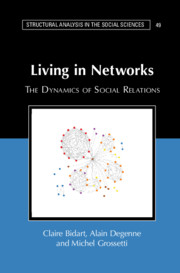Book contents
- Living in Networks
- Structural Analysis in the Social Sciences
- Living in Networks
- Copyright page
- Contents
- Figures
- Tables
- Preface
- Acknowledgments
- Introduction
- Part I Foundations of a Sociology of Relational Dynamics
- Part II Networks and Their Dynamics
- Part III Networks and Social Worlds
- 8 Networks Have a Spatial Dimension
- 9 Soft Segregation
- 10 Relationships and Networks As Resources
- 11 Unequal Networks
- 12 Networks Online and Offline
- Conclusion
- References
- Index
- Structural Analysis in the Social Sciences
8 - Networks Have a Spatial Dimension
from Part III - Networks and Social Worlds
Published online by Cambridge University Press: 27 October 2020
- Living in Networks
- Structural Analysis in the Social Sciences
- Living in Networks
- Copyright page
- Contents
- Figures
- Tables
- Preface
- Acknowledgments
- Introduction
- Part I Foundations of a Sociology of Relational Dynamics
- Part II Networks and Their Dynamics
- Part III Networks and Social Worlds
- 8 Networks Have a Spatial Dimension
- 9 Soft Segregation
- 10 Relationships and Networks As Resources
- 11 Unequal Networks
- 12 Networks Online and Offline
- Conclusion
- References
- Index
- Structural Analysis in the Social Sciences
Summary
How do networks behave with regard to spatial divisions, do they respect or transgress distances, qualifications of spaces, mobilities? Can the development of new means of communicating over distance change this relationship of networks to space? Where do our relatives or, more generally, those with whom we are in contact live? Are we close (spatially) to our close (emotionally) ones ? What are the effects of urban evolutions on relational structures? How does spatial mobility influence networks? This is the issue of the spatial dimension of personal networks or, to put it another way, the link between "spatial" proximity and "relational" proximity. We show the importance of the local (city-wide) dimension of networks, but also their ability to retain their structure after mobility, despite significant changes in their composition.
- Type
- Chapter
- Information
- Living in NetworksThe Dynamics of Social Relations, pp. 193 - 209Publisher: Cambridge University PressPrint publication year: 2020

